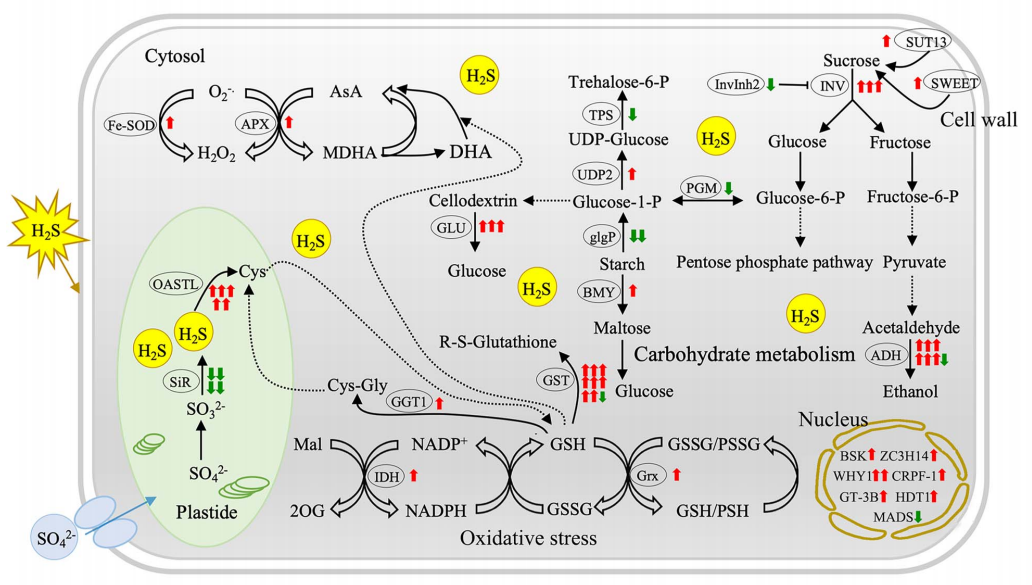Li H., Ghoto K., Wei M.Y., Gao C.H., Liu Y.L., Ma D.N. and Zheng H.L.. 2021. Tree Physiology, 41(9):1749-1766.
Mangroves are the main intertidal ecosystems with varieties of root types along the tropical and subtropical coastlines around the world. The typical characteristics of mangrove habitats, including the abundant organic matter and nutrients, as well as the strong reductive environment, are favor for the production of hydrogen sulfide (H2S). H2S, as a pivotal signaling molecule, has been evidenced in a wide variety of plant physiological and developmental processes. However, whether H2S functions in the mangrove root system establishment is not clear yet. Here, we reported the possible role of H2S in regulation of Kandelia obovata root development and growth by tandem mass tag (TMT)-based quantitative proteomic approaches coupled with bioinformatic methods. The results showed that H2S could induce the root morphogenesis of K. obovata in a dose-dependent manner. The proteomic results successfully identified 8075 proteins, and 697 were determined as differentially expressed proteins. Based on the functional enrichment analysis, we demonstrated that H2S could promote the lateral root development and growth by predominantly regulating the proteins associated with carbohydrate metabolism, sulfur metabolism, glutathione metabolism and other antioxidant associated proteins. In addition, transcriptional regulation and brassinosteroid signal transduction associated proteins also act as important roles in lateral root development. The protein-protein interaction analysis further unravels a complicated regulation network of carbohydrate metabolism, cellular redox homeostasis, protein metabolism, secondary metabolism, and amino acid metabolism in H2S-promoted root development and growth of K. obovata. Overall, our results revealed that H2S could contribute to the morphogenesis of the unique root system of mangrove plant K. obovata, and play a positive role in the adaption of mangrove plants to intertidal habitats.

Figure 1. Schematic presentation of H2S promoting the lateral root development and growth of mangrove plant K. obovata. The expression profiles of DEPs are marked in arrows. Red color represents up-regulated, green color represents down-regulated in expression abundance. ADH, alcohol dehydrogenase; APX2, L-ascorbate peroxidase 2; AsA, ascorbic acid; BMY, beta-amylase; BSK, BR-signaling kinase; CRPF-1, one common plant regulatory factor 1-like isoform X1; Cys, cysteine; Cys-Gly, L-Cysteinyl glycine; DHA, reduced ascorbate acid; Fe-SOD, superoxide dismutase [Fe]; GGT, gamma-glutamyl transpeptidase; glgP, glycogen phosphorylase; GLU, beta-glucosidase; GPX, glutathione peroxidase; Grx, glutaredoxin; GSH, glutathione; GSSG, oxidized glutathione; GST, glutathione S-transferase; GT-3B, trihelix transcription factor GT-3b; HDT1, histone deacetylase HDT1; IDH, isocitrate dehydrogenase; InvInh2, cell wall/vacuolar inhibitor of fructosidase 2; INV, invertase; Mal, malic acid; MADS, MADS-box transcription factor; MDHA, monodehydroascorbate; OASTL, cysteine synthase; 2OG, α-ketoglutarate; PGM, phosphoglucomutase; POD, peroxidase; PSH, protein thiols; PSSG, protein–protein disulfides; SiR, sulfite reductase; SUT13, sugar transport protein 13; SWEET, bidirectional sugar transporter SWEET; TPS, trehalose 6-phosphate synthase; UGP, UTP-glucose-1-phosphate uridylyl transferase. WHY1, two single-stranded DNA-binding protein WHY1; ZC3H14, zinc finger CCCH domain-containing protein 14.

